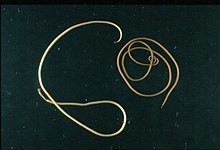Paragordius
| Paragordius | |
|---|---|

| |
| Paragordius tricuspidatus | |
| Scientific classification | |
| Kingdom: | Animalia |
| Phylum: | Nematomorpha |
| Class: | Gordioida |
| Order: | Gordioidea |
| Family: | Chordodidae |
| Genus: | Paragordius Camerano, 1897 |
Paragordius is a genus of worms belonging to the family Chordodidae.[1] It was independently described by both Lorenzo Camerano in 1897 and Thomas Harrison Montgomery Jr. in 1898, though both authors gave the genus the same name.[2]
The genus has almost cosmopolitan distribution,[1] although most species are known from the Afrotropic and Neotropic regions.[2] Females of the genus are notable for having three posterior lobes, while males have long tail lobes, allowing Paragordius species to be readily identified.[2]
- Swanteson-Franz, Marquez, Goldstein, Schmidt-Rhaesa, Bolek & Hanelt, 2018
- Zanca & De Villalobos, 2006
- Linstow, 1906
- Linstow, 1906
- Sciacchitano, 1958
- Heinze, 1935
- (Camerano, 1895)
- Carvalho, 1942
- Linstow, 1906
- Sciacchitano, 1958
- Sciacchitano, 1958
- Carvalho, 1944
- Sciacchitano, 1958
- Hanelt, 2012
- Sciacchitano, 1962
- (Linstow, 1883)
- Sciacchitano, 1958
- Paragordius tricuspidatus (Dufour, 1828)
- Paragordius varius (Leidy, 1851)
References[]
Categories:
- Nematomorpha